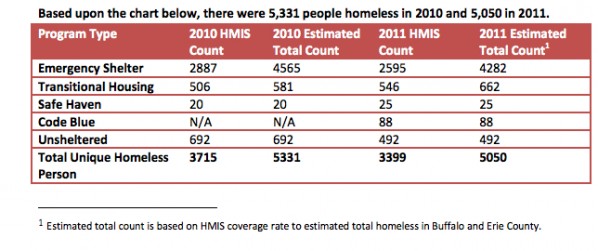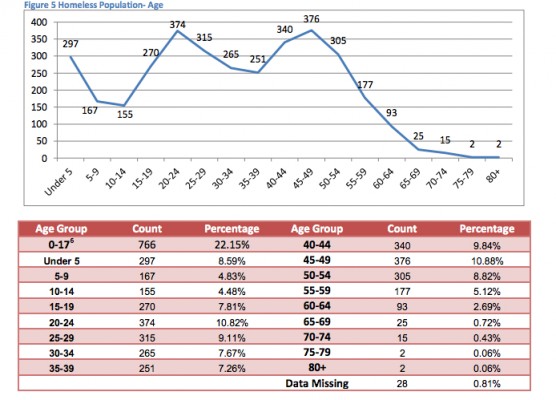Dec 12
2012
A snapshot of the homeless in Buffalo area

The snapshot of homelessness that the U.S. Department of Housing and Urban Development released today shows a slight decline in the total population of homeless people in the United States for a single day in January 2012.
“Our local numbers sort of mirror the national numbers,” said Dale Zuchlewski, the executive director of the Homelessness Alliance of Western New York.
But that doesn’t mean Zuchlewski is breathing a sigh of relief.
The Buffalo/Erie County Continuum of Care reported 120 chronically homeless people on that January day, down from 129 in 2011. Another positive that Zuchlewski pointed out is that the number of unsheltered homeless veterans dropped from 13 to four, and by an even greater number when you look at the annual statistics.
But let’s move away from the snapshot and look at the full picture because Zuchlewski said he is spotting some trends that concern him.
 In 2011, there were 5,050 people who experienced homelessness in Erie County and Buffalo. On any given night there were about 1,000 people homeless. Those numbers are down from 2010.
In 2011, there were 5,050 people who experienced homelessness in Erie County and Buffalo. On any given night there were about 1,000 people homeless. Those numbers are down from 2010.
But here is where it starts to get dicey.
“You almost feel like that hamster on the wheel sometimes.”
— Dale Zuchlewski, the executive director of the Homelessness Alliance of Western New York
Zuchlewski said 40 percent of the people who are homeless in Erie County and Buffalo became homeless for the first time.
About 58 percent of renters are paying more than 30 percent of their income to rent in the city, and the same holds true for about 52 percent in Erie County.
That means a lot of people are living paycheck to paycheck.
“That’s disheartening,” he said. “You almost feel like that hamster on the wheel sometimes.”
“Just one life event, if you get sick at work, a lot of people don’t have sick days. If you don’t have sick days at work you go payless,” he said.
“If it is for an extended period of time you begin to have financial problems. If someone dies or if your car breaks down it just throws you into a cycle of not being able to pay your bills.”
Those statistics translate into a growing number of homeless single mothers and homelessness among young adults 18 to 24.
“When people think of homeless, they think of that old guy pushing the shopping cart down the street, but they don’t think of that single mom or a victim of domestic violence fleeing for her safety with her kids.
“So that is concerning, but that is due mostly to the level of poverty among single moms,” he said.
“Back when I was growing up, kids graduating from high school could get a job at Bethlehem Steel or Chevy — and those were good paying jobs. Those jobs aren’t here anymore.”
Residents with only high school diplomas face an even tougher climb now because they do not make a decent wage at the local mall or retail store.
“You almost have to have a masters degree now to get a decent job and there are a lot of out-of-work teachers and a lot of out-of-work lawyers. If you’re graduating with a high school diplomia or maybe not even a diploma, it is even more competitive,” he said.
Zuchlewski said national studies show that caring for the older homeless population — ages 45 to 62 — is the most expensive. If they get mixed up with the legal system, as many of them can, it gets even more expensive.
“You end up in jail at $125 a night when we can shelter someone for $40 or $50,” he said. “If that person ends up sick or ill, it’s an ambulance call or an emergency room visit. It is costly to ignore the homeless population.
“Unless we do something with that younger population now they are going to end up being the high-cost people in the future.”
Zuchlewski said the city has $450,000 in federal funds to spend on the Rapid Re-Housing program and that the money will target single moms and young adults who are homeless.
“That is a nationally proven successful model,” he said about Rapid Re-Housing. “I would say there’s hope. There’s work to do, but we have to make sure that people know there are some cost savings in helping the homeless.”

